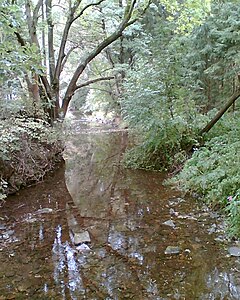Lenne (nature reserve)
|
Lenne
|
||
|
Lenne at Wickensen |
||
| location | Lenne ( Bodenwerder to the east of Stadtoldendorf ), Holzminden district , Lower Saxony | |
| surface | 113 ha | |
| Identifier | NSG HA 226 | |
| FFH area | 48.35 hectares | |
| Geographical location | 51 ° 57 ' N , 9 ° 36' E | |
|
|
||
| Sea level | from 75 m to 300 m | |
| Setup date | June 25, 2019 | |
The Lenne is a nature reserve in the Lower Saxony municipalities of Wangelnstedt , Lenne , Eimen , Lüerdissen , Dielmissen and Kirchbrak , the cities of Stadtoldendorf , Eschershausen and Bodenwerder and the municipality-free area of Eimen in the Holzminden district .
General
The nature reserve with the sign NSG HA 226 is about 113 hectares . The approximately 48 hectare FFH area of the same name is part of the nature reserve. At the same time it partially overlaps with the EU bird sanctuary "Sollingvorland". The nature reserve is in many cases the conservation area surrounded "Solling foreland Wesertal". Between Eschershausen and Kirchbrak, the “ Tuchtberg ” nature reserve connects to the north . The area has been under nature protection since June 25, 2019. The responsible lower nature conservation authority is the district of Holzminden.
description
The nature reserve stretches along the Lenne , a right tributary of the Weser in the Weserbergland , from the crossing of the Lenne through the state road 546 in Wangelnstedt to its confluence with the Weser near Bodenwerder. It includes the tributaries Flötebach, Hilsbach, Jakobsgraben, Silberborn and Wabach or parts of the tributaries. The nature reserve includes the running waters with their bank areas as well as areas adjoining them in places. The flowing waters are close to nature with structurally rich sections of water with gravel banks , rapids and dead wood .
The Lenne and its tributaries within the nature reserve mostly from the gallery forest pronounced woody plants with Common ash , alder , silver , breakage and Fahl Weide and Common hazel u. a. with Winkelsegge , giant fescue , High Key Flower and Blutampfer accompanied in the understory to which Hochstaudenfluren with Genuine meadowsweet , marsh cranesbill , Exceptional loosestrife and loosestrife join. On their way into the Lenne valley, the tributaries also flow through wooded slopes of Hils , Homburg and Vogler , on which their source areas are located. The forests are pronounced as beech-beech forests , in the area of the springs alder-spring forests , and along the streams also alluvial forests .
The flowing waters accommodate u. a. Bullhead and brown trout , in the lower reaches of the Lenne also loaches and minnow are native. They are also the habitat of various invertebrate species. The forests are the habitat of the wild cat , a protected bird species such as black stork , gray-headed woodpecker and black woodpecker and various amphibians , including the spotted salamander . Forests and woody trees that accompany watercourses have a high proportion of old and dead wood.
Web links
- Nature reserve "Lenne" in the database of the Lower Saxony State Office for Water Management, Coastal and Nature Conservation (NLWKN)
Individual evidence
- ↑ a b Lenne , profiles of the Natura 2000 areas, Federal Agency for Nature Conservation . Retrieved August 16, 2019.



